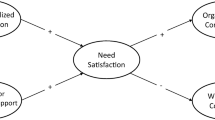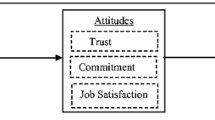Abstract
The purpose of this study is to examine the relations between principals’ perceived autonomy support from superintendents, affective commitment to their school districts, and job satisfaction. We also explore possible moderation effects of principals’ career experiences on these relations. Data were collected from K-12 public school principals in the United States (\(N =\) 1,501) who completed an online survey. Data were analyzed using hierarchical regression analyses. The results indicate that principals are more likely to be affectively committed to their school districts and more satisfied with their jobs when they perceive their superintendents as more autonomy supportive. In addition, we found a significant interaction between perceived autonomy support and years of employment by current school districts indicating that the relation between autonomy support and affective commitment is particularly important for principals with fewer years of experience in their current school districts. The results of the present study suggest that superintendents should work to ensure that principals perceive a sense of encouragement, understanding, and decision-making support, especially principals with less experience in the school district.

Similar content being viewed by others
References
Adamowski, S., & Petrilli, M. J. (2007). Confronting the autonomy gap. Principal, 87(2), 46–49.
Allen, N. J., & Meyer, J. P. (1990). The measurement of antecedents of affective, continuance, and normative commitment to the organization. Journal of Occupational Psychology, 63, 1–18.
Allen, N. J., & Meyer, J. P. (1996). Affective, continuance, and normative commitment to the organization: An examination of construct validity. Journal of Vocational Behavior, 49(3), 252–276.
Anderman, E. M. (2012). Adolescence. In K. R. Harris, S. Graham, & T. Urdan (Eds.), APA handbook of educational psychology: Applications to learning and teaching (Vol. 3, pp. 43–61). Washington, DC: American Psychological Association.
Anderman, E. M., & Maehr, M. L. (1994). Motivation and schooling in the middle grades. Review of Educational Research, 64, 287–309.
Andrews, F. M., & Withey, S. B. (1976). Social indicators of well-being: Americans’ perceptions of life quality. New York: Plenum.
Assor, A., Kaplan, H., & Roth, G. (2002). Choice is good, but relevance is excellent: Autonomy-enhancing and suppressing teacher behaviours predicting students’ engagement in schoolwork. The British Journal of Educational Psychology, 72, 261–278.
Aube, C., Rousseau, V., & Morin, E. M. (2007). Perceived organizational support and organizational commitment: The moderating effect of locus of control and work autonomy. Journal of Managerial Psychology, 229, 479–495.
Baard, P. P., Deci, E. L., & Ryan, R. M. (2004). Intrinsic need satisfaction: A motivational basis of performance and well-being in two work settings. Journal of Applied Social Psychology, 34, 2045–2068.
Barry, A., Friedman, M., & Markow, D. (2008). Predictors of principals’ satisfaction with their schools. Journal of Educational Administration, 46(5), 598–612.
Bridge, R. G. (1974). Nonresponse bias in mail surveys: The case of the department of defense post-service survey. Santa Monica: Rand.
Clark, D. (2009). The performance and competitive effects of school autonomy. Journal of Political Economy, 117(4), 745–783.
Colarelli, S. M., Dean, R. A., & Konstans, C. (1987). Comparative effects of personal and situational influences on job outcomes of new professionals. Journal of Applied Psychology, 72, 558–566.
Connelly, G. (2009). Balancing accountability with autonomy and authority. Principal, 88(4), 64.
Deci, E. L., Connell, J. P., & Ryan, R. M. (1989). Self-determination in a work organization. Journal of Applied Psychology, 74(4), 580–590.
Deci, E. L., Eghrari, H., Patrick, B. C., & Leone, D. R. (1994). Facilitating internalization: The self-determination theory perspective. Journal of Personality, 62, 119–142.
Deci, E. L., & Moller, A. (2005). The concept of competence: A starting place for understanding intrinsic motivation and self-determinated extrinsic motivation. In A. Elliot & C. Dweck (Eds.), Handbook of competence and motivation (pp. 579–597). New York: Guilford Press.
Deci, E. L., & Ryan, R. M. (1985). Intrinsic motivation and self-determination in human behavior. New York: Plenum.
Deci, E. L., & Ryan, R. M. (2002). An overview of self-determination theory: An organismic-dialectical perspective. In E. L. Deci & R. M. Ryan (Eds.), Handbook of self-determination research (pp. 3–36). Rochester, NY: University of Rochester Press.
Deci, E. L., Ryan, R. M., Gagné, M., Leone, D. R., Usunov, J., & Kornazheva, B. P. (2001). Need satisfaction, motivation, and well-being in the work organizations of a former eastern bloc country. Personality and Social Psychology Bulletin, 27, 930–942.
Dunham, R. B., Grube, J. A., & Castaneda, M. B. (1994). Organizational commitment: The utility of an integrative definition. Journal of Applied Psychology, 79, 370–380.
Eckman, E. W. (2004). Similarities and differences in role conflict, role commitment, and job satisfaction for female and male high school principals. Educational Administration Quarterly, 40(3), 366–387.
English, B., & Charlon, C. (2011). Strengthening affective organizational commitment: The influence of fairness perceptions of management practices and underlying employee cynicism. Health Care Manager, 30(1), 29–35.
Goodwin, R. H., Cunningham, M. L., & Childress, R. (2003). The changing role of the secondary principal. Nassp Bulletin, 87(634), 26–42.
Graham, M. W., & Messner, P. E. (1998). Principals and job satisfaction. International Journal of Educational Management, 12(5), 196–202.
Grolnick, W. S., Ryan, R. M., & Deci, E. L. (1991). Inner resources for school achievement: Motivational mediators of children’s perceptions of their parents. Journal of Educational Psychology, 83(4), 508–517.
Groves, R. M. (2006). Nonresponse rates and nonresponse bias in household surveys. Public Opinion Quarterly, 70(5), 646–675.
Hardré, P. L., & Reeve, J. (2009). Training corporate managers to adopt a more autonomy-supportive motivating style toward employees: An intervention study. International Journal of Training and Development, 13(3), 165–184.
Hawkins, W. D. (1998). Predictors of affective organizational commitment among high school principals (Doctoral dissertation). Retrieved from http://scholar.lib.vt.edu/theses/available/etd-32298-1310/unrestricted/DISSERTATION.PDF
Herr, K. (1999). The symbolic use of participation: Co-opting change. Theory into Practice, 38, 235–240.
Luyckx, K., Goossens, L., Duriez, B., & Vansteenkiste, M. (2009). Basic need satisfaction and identity formation: Bridging self-determination theory and process-oriented identity research. Journal of Counseling Psychology, 56(2), 276–288.
Lynch, M. F., Plant, R. W., & Ryan, R. M. (2005). Psychological needs and threat to safety: Implications for staff and patients in a psychiatric hospital for youth. Professional Psychology, 36, 415–425.
Mathieu, J. E., & Zajac, D. M. (1990). A review and meta-analysis of the antecedents, correlates, and consequences of organizational commitment. Psychological Bulletin, 108, 171–194.
Milyavskaya, M., & Koestner, R. (2011). Psychological needs, motivation, and well-being: A test of self-determination theory across multiple domains. Personality and Individual Differences, 50(3), 387–391.
Minnaert, A., Boekaerts, M., & de Brabander, C. (2007). Autonomy, competence, and social relatedness in task interest within project-based education. Psychological Reports, 101(2), 574–586.
Mitchell, C. M. (2010). Job satisfaction of elementary principals in large urban communities (Doctoral dissertation). Retrieved from http://ecommons.txstate.edu/cgi/viewcontent.cgi?article=1011&context=eapstad&sei-redir=1#search=%22Mitchell%2C%20Job%20satisfaction%20elementary%20principals%20large%20urban%20communities%22
Morrison, G. M., & Allen, M. R. (2007). Promoting student resilience in school contexts. Theory Into Practice, 46, 162–169.
Morrow, P. (2011). Managing organizational commitment: Insights from longitudinal research. Journal of Vocational Behavior, 79(1), 18–35.
Mowday, R. T., Steers, R. M., & Porter, L. W. (1978). The measurement of organizational commitment: A progress report. Eugene, OR: Graduate School of Management, University of Oregon.
National Center for Education Statistics. (2013). Number, highest degree, average years of experience, and salaries of principals in public and private elementary and secondary schools, by selected characteristics: 1993–94, 2003–04, and 2011–12. Retrieved September 12, 2014 from http://nces.ed.gov/programs/digest/d13/tables/dt13_212.10.asp
Newby, J. E. (1999). Job satisfaction of middle school principals in Virginia (Doctoral dissertation). Retrieved from http://scholar.lib.vt.edu/theses/available/etd-031899-164059/unrestricted/BIBLIO2.PDF
Oplatka, I., & Mimon, R. (2008). Women principals’ conceptions of job satisfaction and dissatisfaction: An alternative view? International Journal of Leadership in Education, 11(2), 135–153.
Reeve, J., Nix, G., & Hamm, D. (2003). Testing models of the experience of self-determination in intrinsic motivation and the conundrum of choice. Journal of Educational Psychology, 95(2), 375–392.
Rentsch, J. R., & Steel, R. P. (1992). Construct and concurrent validation of the Andrews and Withey Job Satisfaction Questionnaire. Educational and Psychological Measurement, 52, 357–367.
Riketta, M. (2002). Attitudinal organizational commitment and job performance: A meta-analysis. Journal of Organizational Behavior, 23(3), 257–266.
Rousseau, V., & Aubé, C. (2010). Social support at work and affective commitment to the organization: The moderating effect of job resource adequacy and ambient conditions. Journal of Social Psychology, 150(4), 321–340.
Ryan, R. M., & Deci, E. L. (2000). Self-determination theory and the facilitation of intrinsic motivation, social development, and wellbeing. American Psychologist, 55, 68–78.
Ryan, R. M., & Deci, E. L. (2009). Promoting self-determined school engagement: Motivation, learning, and well-being. In K. R. Wentzel & A. Wigfield (Eds.), Handbook of motivation at school (pp. 171–196). New York, NY: Routledge.
Shapira-Lishchinsky, O. (2010). School ethical climate and teachers’ voluntary absence. Journal of Educational Administration, 48(2), 164–181.
Sodoma, B., & Else, D. (2009). Job satisfaction of Iowa public school principals. Rural Educator, 31(1), 10–18.
Steinberg, M. (2014). Does greater autonomy improve school performance? Evidence from a regression discontinuity analysis in Chicago. Education Finance and Policy, 9(1), 1–35.
Vansteenkiste, M., Niemiec, C., & Soenens, B. (2010). The development of the five mini theories of self-determination theory: An historical overview, emerging trends, and future directions. In T. Urdan & S. Karabenick (Eds.), Advances in motivation and achievement: The decade ahead (Vol. 16, pp. 105–166). Bingley, UK: Emerald Publishing.
Williams, G. C., & Deci, E. L. (1996). Internalization of biopsychosocial values by medical students: A test of self-determination theory. Journal of Personality and Social Psychology, 70, 767–779.
Williams, G. C., Grow, V. M., Freedman, Z., Ryan, R. M., & Deci, E. L. (1996). Motivational predictors of weight loss and weight-loss maintenance. Journal of Personality and Social Psychology, 70, 115–126.
Author information
Authors and Affiliations
Corresponding author
Rights and permissions
About this article
Cite this article
Chang, Y., Leach, N. & Anderman, E.M. The role of perceived autonomy support in principals’ affective organizational commitment and job satisfaction. Soc Psychol Educ 18, 315–336 (2015). https://doi.org/10.1007/s11218-014-9289-z
Received:
Accepted:
Published:
Issue Date:
DOI: https://doi.org/10.1007/s11218-014-9289-z




